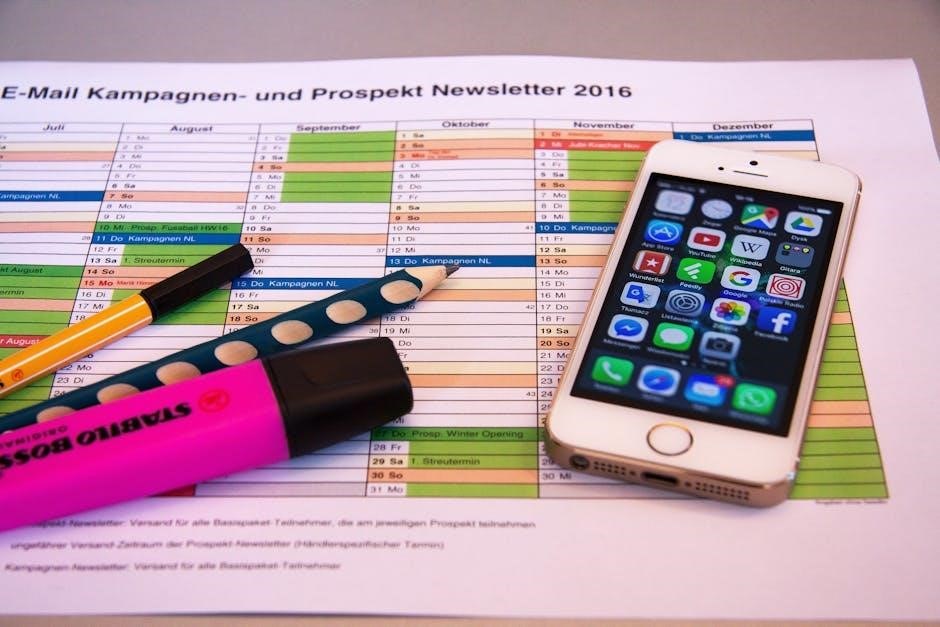A newsletter is a regularly distributed publication sharing information about a specific topic or organization․ Its primary goal is to engage and inform target audiences effectively․ Originating in print‚ newsletters have evolved into digital formats‚ offering versatile communication tools for businesses‚ educators‚ and creators․ They remain a vital medium for sharing updates‚ insights‚ and stories‚ fostering connection and loyalty with readers worldwide․
1․1 Definition and Purpose of Newsletters
A newsletter is a regularly distributed publication that shares information‚ updates‚ and insights on specific topics or activities․ Its primary purpose is to engage‚ inform‚ and connect with a target audience․ Newsletters serve as a communication tool for businesses‚ educators‚ and creators to promote products‚ share knowledge‚ or build relationships․ They often include updates‚ articles‚ and resources tailored to the interests of subscribers‚ aiming to foster loyalty and maintain ongoing engagement with the audience․
1․2 Brief History of Newsletters
Newsletters trace their origins to the 17th century as handwritten letters sharing news and updates․ Initially‚ they were distributed among royal courts and merchants․ Over time‚ they evolved into printed formats‚ becoming essential tools for businesses‚ organizations‚ and communities․ The advent of email and digital technology revolutionized newsletters‚ making them more accessible and widespread․ Today‚ newsletters remain a vital communication method‚ adapting to modern trends like personalization and automation to stay relevant in the digital age․
1;3 Importance of Newsletters in Modern Communication
Newsletters play a crucial role in modern communication by fostering direct connections with audiences․ They enable organizations to share tailored content‚ updates‚ and insights‚ enhancing engagement and loyalty․ Newsletters are cost-effective‚ allowing businesses to reach specific demographics without extensive resources․ They also provide measurable outcomes‚ helping track audience interactions and preferences․ In a crowded digital space‚ newsletters stand out as a personalized and reliable medium for conveying value‚ making them indispensable for effective communication strategies․

Types of Newsletters
Newsletters vary by purpose‚ including company newsletters for internal updates‚ educational newsletters for learning‚ nonprofit newsletters for advocacy‚ and personal newsletters for individual insights and connections․
2․1 Company Newsletters
Company newsletters serve as internal communication tools‚ fostering team unity and alignment․ They often include updates on company achievements‚ new projects‚ employee spotlights‚ and industry trends․ These newsletters help maintain transparency‚ boost morale‚ and ensure everyone is informed about organizational goals and initiatives; They also provide a platform for leadership to share visions and values‚ enhancing workplace culture and collaboration․
2․2 Educational Newsletters
Educational newsletters are designed to engage students‚ parents‚ and staff with academic updates‚ event announcements‚ and resources․ They often feature student achievements‚ upcoming deadlines‚ and educational tips․ These newsletters foster a sense of community and keep stakeholders informed about school activities and initiatives․ By providing valuable content‚ they support learning and involvement‚ making them an essential tool for educational institutions to communicate effectively with their audience․
2․3 Nonprofit Newsletters
Nonprofit newsletters are essential tools for raising awareness‚ sharing success stories‚ and engaging supporters․ They often highlight mission-driven content‚ upcoming events‚ and volunteer opportunities․ These newsletters also serve to recognize donors and showcase the impact of contributions․ By fostering transparency and trust‚ nonprofits can build stronger relationships with their audience‚ ensuring continued support for their causes and initiatives․
2․4 Personal Newsletters
Personal newsletters are a unique way for individuals to share their thoughts‚ experiences‚ and expertise․ They often serve as a platform for self-expression‚ allowing creators to connect with like-minded audiences․ These newsletters may include personal stories‚ opinions‚ or insights on specific topics․ Many creators use platforms like Substack or ConvertKit to craft and distribute personal newsletters‚ fostering authentic connections and building loyal communities․ They are ideal for writers‚ thinkers‚ and anyone seeking to share their voice with the world․

Key Elements of a Successful Newsletter
A successful newsletter requires engaging subject lines‚ clear and concise content‚ and visually appealing design․ These elements ensure readability‚ captivate audiences‚ and drive desired actions effectively․
3․1 Engaging Subject Lines
Crafting compelling subject lines is crucial for capturing attention․ They should be concise‚ clear‚ and intriguing‚ prompting recipients to open the newsletter․ Personalization and urgency can enhance effectiveness‚ ensuring higher engagement rates․ Avoid spam triggers to maintain deliverability․ Effective subject lines balance creativity with clarity‚ reflecting the content within; They are the first impression‚ making them vital for newsletter success and audience retention․
3․2 Compelling Content Structure
A well-structured newsletter ensures readability and engagement․ Begin with a strong header and introduction‚ followed by concise‚ organized sections․ Use visuals like images or charts to break up text and enhance comprehension․ Maintain clarity with short paragraphs and bullet points․ A logical flow from introduction to conclusion keeps readers interested․ Proper formatting‚ including headers and subheaders‚ guides the reader effortlessly․ Ensure each section is digestible‚ balancing text and visuals for an appealing layout that captivates and informs effectively․
3․3 Visual Appeal and Design
Visual appeal is crucial for capturing attention and enhancing readability․ Use high-quality images‚ infographics‚ and consistent color schemes to create a professional look․ Select fonts that are easy to read and align with your brand identity․ Incorporate white space strategically to avoid clutter․ Ensure visuals complement the text‚ drawing attention to key points․ A well-designed newsletter fosters engagement and reflects your brand’s professionalism․ Tools like Canva simplify the creation of visually stunning layouts‚ even for non-designers․

Content Strategy for Newsletters
A strong content strategy involves identifying your audience‚ crafting relevant and valuable content‚ and balancing informative and entertaining elements to engage readers effectively․
4․1 Identifying Target Audience
Identifying your target audience is crucial for creating effective newsletters․ Understanding demographics‚ interests‚ and preferences helps tailor content to meet their needs․ Researching user behavior and feedback ensures relevance‚ fostering deeper engagement and loyalty․ By segmenting your audience‚ you can deliver personalized content‚ enhancing the newsletter’s impact and resonance․ This step is foundational for a successful content strategy‚ ensuring your message reaches and connects with the right people․
4․2 Crafting Relevant and Valuable Content
Crafting relevant and valuable content is essential for engaging your audience․ Start by understanding their needs and interests‚ ensuring your content addresses their pain points or curiosity․ Use clear‚ concise language and avoid jargon․ Personalize your approach to make readers feel understood․ Include actionable insights‚ tips‚ or exclusive offers to add value․ Consistency in tone and quality builds trust․ Always aim to educate‚ entertain‚ or inspire‚ keeping your content fresh and aligned with your audience’s expectations for a lasting impact․
4․3 Balancing Information and Entertainment
Balancing information and entertainment in newsletters is crucial for engaging readers․ Combine factual content with storytelling‚ humor‚ or relatable anecdotes to captivate your audience․ Use visuals like images or videos to break up text and enhance appeal․ Ensure the tone remains professional yet approachable‚ avoiding overly formal language․ Mix educational insights with lighter‚ entertaining elements to maintain interest and encourage readers to stay engaged from start to finish‚ fostering loyalty and satisfaction․

Tools and Software for Creating Newsletters
Popular tools like Canva‚ Mailchimp‚ and Substack simplify newsletter creation․ They offer templates‚ design features‚ and automation‚ making it easy to craft professional and engaging newsletters efficiently․
5․1 Overview of Popular Newsletter Tools
Popular newsletter tools include Canva‚ Mailchimp‚ Substack‚ and HubSpot․ These platforms offer user-friendly interfaces for designing‚ writing‚ and distributing newsletters․ Canva excels in visual design‚ while Mailchimp and HubSpot provide robust automation features․ Substack is ideal for creators seeking monetization options․ ConvertKit caters to bloggers and entrepreneurs with advanced personalization․ These tools streamline content creation‚ audience engagement‚ and analytics‚ making newsletter management efficient and accessible for both beginners and professionals․ They integrate seamlessly with other tools‚ enhancing overall productivity․
5․2 Canva for Designing Visually Appealing Newsletters
Canva is a top choice for creating visually stunning newsletters due to its user-friendly interface and extensive template library․ With a drag-and-drop editor‚ users can easily customize layouts‚ fonts‚ and colors to match their brand․ It offers collaboration tools for teamwork and a free version for basic needs․ Canva’s intuitive design features ensure professional-looking newsletters without requiring advanced design skills‚ making it accessible for both novices and professionals aiming to captivate their audience with visually engaging content․
5․3 Using ChatGPT for Content Generation
ChatGPT is a powerful tool for generating newsletter content‚ offering tailored suggestions and drafts․ It can propose engaging topics‚ craft compelling introductions‚ and even assist with writer’s block․ By analyzing data and user preferences‚ ChatGPT helps create personalized content that resonates with audiences․ Its ability to adapt tone and style ensures consistency with brand voice‚ making it an invaluable resource for creators aiming to produce high-quality‚ engaging newsletters efficiently․

Best Practices for Writing Newsletters
Clarity and conciseness are key․ Use engaging language‚ focus on reader benefits‚ and include a clear call-to-action․ Regularly refine content based on feedback and analytics for improvement․
6․1 Keeping Content Concise and Clear
Keeping content concise and clear is essential for engaging readers․ Avoid lengthy paragraphs and jargon․ Use simple language to convey your message effectively․ Ensure each section focuses on one key idea․ Break down information into bullet points or short sentences for easy readability․ This approach helps maintain reader interest and ensures your newsletter is both informative and easy to digest․
6․2 Using a Conversational Tone
A conversational tone in newsletters helps build a personal connection with readers․ It makes content feel more approachable and relatable‚ as if you’re speaking directly to them․ Avoid overly formal language and adopt a friendly‚ casual style․ Use everyday expressions and share personal anecdotes to create a sense of familiarity․ This tone fosters trust and engagement‚ making your newsletter more enjoyable and easier to read․
6․3 Incorporating Call-to-Action (CTA)
Incorporating a call-to-action (CTA) in your newsletter is essential for guiding readers toward desired actions․ A well-crafted CTA should be clear‚ specific‚ and compelling‚ using action verbs like “Sign Up‚” “Learn More‚” or “Shop Now․” It should create a sense of urgency‚ such as ” Limited Time Offer – Act Now!” Placement is key; CTAs should appear near the top or following a valuable piece of content․ This encourages engagement and helps achieve your newsletter’s goals effectively․

Distribution and Subscription Strategies
Effective distribution and subscription strategies ensure your newsletter reaches the right audience․ Use segmentation‚ automation‚ and clear sign-up processes to grow your subscriber base and maintain engagement consistently․
7․1 Building an Email List
Building a quality email list is crucial for newsletter success․ Offer incentives like exclusive content or discounts to encourage sign-ups․ Use opt-in forms on your website‚ social media‚ and landing pages to capture leads․ Segment your audience based on interests or demographics to personalize content․ Regularly clean your list to remove inactive subscribers and improve engagement rates․ Ethical practices ensure trust and compliance with data protection laws․
7․2 Frequency of Newsletter Distribution
Determining the optimal frequency for distributing newsletters is essential to maintain audience engagement․ Weekly newsletters work well for audiences seeking regular updates‚ while monthly formats are ideal for in-depth content․ Consistency is key to building trust and anticipation․ Consider your audience’s preferences‚ content availability‚ and the purpose of your newsletter when deciding frequency․ Avoid overwhelming subscribers with too many emails‚ but ensure regular communication to keep them informed and interested․
7․3 Optimizing Delivery Rates
Optimizing newsletter delivery rates involves maintaining a clean email list‚ avoiding spam filters‚ and ensuring sender reputation․ Regularly remove inactive or bounced addresses to improve deliverability․ Use authentication protocols like SPF and DKIM to verify your identity․ Avoid triggering spam keywords and ensure content relevance․ Segment your audience for personalized delivery․ Monitor delivery metrics to identify issues and adjust strategies accordingly․ Compliance with data protection laws and email regulations also enhances delivery success rates and subscriber trust․

Measuring Newsletter Performance
Measuring newsletter performance involves analyzing data to assess engagement‚ effectiveness‚ and subscriber behavior‚ enabling informed decisions to enhance content quality and achieve communication goals successfully․
8․1 Key Performance Indicators (KPIs)
Key Performance Indicators (KPIs) are essential metrics for evaluating newsletter success․ Common KPIs include open rates‚ click-through rates‚ and conversion rates‚ which provide insights into audience engagement․ Open rates indicate how many subscribers opened the newsletter‚ while click-through rates measure the number of clicks on links․ Conversion rates track actions like purchases or sign-ups․ These metrics help gauge the effectiveness of content and guide improvements to better align with audience preferences and goals․ By consistently monitoring these KPIs‚ creators can refine their strategies to enhance newsletter performance and achieve desired outcomes effectively․ Additionally‚ these metrics allow for data-driven decisions‚ ensuring that newsletters remain relevant and impactful over time․ Regular analysis of KPIs is crucial for maintaining high engagement and driving the intended results‚ making them a cornerstone of successful newsletter campaigns․ Thus‚ understanding and leveraging these indicators is vital for optimizing newsletter strategies and maximizing their potential․
8․2 Analyzing Open Rates and Click-Through Rates
Open rates and click-through rates (CTR) are critical metrics for assessing newsletter performance․ Open rates measure how many subscribers opened the email‚ reflecting the effectiveness of subject lines and sender credibility․ CTR indicates how many recipients clicked on links within the newsletter‚ revealing content relevance and engagement․ Analyzing these metrics helps identify strengths and weaknesses‚ guiding improvements to subject lines‚ content structure‚ and calls-to-action․ High open rates and CTR often correlate with well-targeted and compelling newsletters‚ ensuring audience engagement and desired outcomes․
8․3 A/B Testing for Improvement
A/B testing is a powerful tool for refining newsletter strategies․ By comparing different versions of subject lines‚ content layouts‚ and calls-to-action‚ marketers can identify which elements drive higher engagement and conversions․ Testing small segments of the audience ensures minimal disruption while yielding actionable insights․ Regular A/B testing fosters continuous improvement‚ helping newsletters evolve to meet subscriber preferences and achieve their intended goals more effectively over time․

Legal and Ethical Considerations
Compliance with data protection laws ensures legal standards․ Ethical practices‚ like transparency and consent‚ build trust and integrity in newsletters‚ fostering loyal subscriber relationships․
9․1 Compliance with Data Protection Laws
Compliance with data protection laws is crucial for newsletters․ Regulations like GDPR and CCPA require clear consent from subscribers and safeguarding their personal data․ Organizations must ensure transparency in data collection and usage‚ providing easy opt-out options․ Failing to comply can result in legal penalties and reputational damage․ Proper data handling practices‚ such as encryption and secure storage‚ are essential to maintain trust and avoid violations․ Adhering to these laws ensures ethical and lawful newsletter distribution․
9․2 Avoiding Spam Filters
9․4 Maintaining Subscriber Trust
Maintaining subscriber trust involves transparency‚ consistency‚ and respect for their preferences․ Clearly state the newsletter’s purpose and frequency to set expectations․ Avoid misleading content or clickbait headlines‚ as this can erode trust․ Use personalization to show subscribers their input is valued․ Include clear unsubscribe links to honor their choices․ Regularly review and update privacy policies to ensure compliance with data protection laws‚ fostering a reliable and trustworthy relationship with your audience․
Case Studies and Examples
Explore real-world examples of successful newsletters‚ analyzing their strategies‚ audience engagement‚ and content creation․ Learn from both triumphs and challenges to refine your approach effectively․
10․1 Successful Newsletter Campaigns
Successful newsletter campaigns captivate audiences by blending compelling content with strategic delivery․ They often feature personalized subject lines‚ engaging visuals‚ and relevant information tailored to subscriber interests․ For instance‚ a company might use segmentation to send targeted updates‚ boosting open rates and click-throughs․ Clear calls-to-action and consistent branding further enhance effectiveness‚ fostering trust and loyalty․ These campaigns serve as models for effective communication‚ demonstrating how newsletters can drive engagement and achieve organizational goals․
10․2 Lessons Learned from Failed Campaigns
Failed newsletter campaigns often highlight common mistakes‚ such as poor subject lines‚ lack of personalization‚ or irrelevant content․ Overly promotional language can alienate readers‚ while inconsistent delivery may lead to disengagement․ Analyzing these failures reveals the importance of understanding the audience and refining strategies․ By studying metrics like open rates and click-through rates‚ creators can identify weaknesses and adjust their approach to better resonate with subscribers‚ ultimately improving future campaigns and enhancing overall effectiveness․

Future Trends in Newsletter Creation
The future of newsletters involves innovative AI tools‚ advanced personalization‚ and seamless integration with social media‚ enhancing engagement and expanding subscriber reach more effectively․
11․1 Role of AI in Newsletter Writing
AI plays a transformative role in newsletter writing by automating content creation‚ personalizing messages‚ and optimizing delivery․ Tools like ChatGPT generate engaging text‚ while AI algorithms analyze subscriber data to tailor content․ This enhances efficiency and creativity‚ ensuring newsletters resonate with diverse audiences․ AI also streamlines design processes‚ enabling visually appealing layouts without extensive design expertise․ By leveraging AI‚ creators can focus on strategic decisions‚ balancing automation with human insight to craft impactful newsletters․
11․2 Personalization and Automation
Personalization and automation are revolutionizing newsletter creation‚ enabling tailored content for individual preferences․ Advanced tools segment audiences and craft dynamic content based on subscriber data․ Automation streamlines scheduling‚ formatting‚ and delivery‚ ensuring consistency and efficiency․ Together‚ these technologies enhance engagement and simplify workflows‚ allowing creators to focus on strategy while delivering highly relevant content to their audience․ This blend of personalization and automation ensures newsletters remain impactful and adaptable to evolving reader needs and preferences․
11․3 Integration with Social Media
Integrating newsletters with social media enhances content reach and engagement by sharing newsletter excerpts or links on platforms like Twitter‚ LinkedIn‚ or Facebook․ This cross-promotion strategy drives traffic and encourages subscriptions․ Embedded social sharing buttons in newsletters facilitate easy content distribution‚ while curated social media content can enrich newsletter issues․ Tools like Mailchimp offer direct integrations‚ simplifying the process․ This synergy between newsletters and social media amplifies brand visibility and fosters a connected audience experience‚ leveraging both channels effectively․
Newsletters remain a powerful tool for communication‚ adapting to digital trends while fostering meaningful connections․ Their enduring value lies in delivering tailored content‚ ensuring continued relevance in modern communication․
12․1 Recap of Key Takeaways
Newsletters are a dynamic and versatile communication tool‚ essential for engaging audiences and delivering value․ They have evolved from traditional print to digital formats‚ offering flexibility and accessibility․ Key elements like compelling content‚ visually appealing design‚ and clear subject lines are crucial for success․ Understanding the target audience and maintaining trust are vital for effective newsletters․ Regular analysis of performance metrics and adaptation to trends ensure long-term relevance․ Personalization and automation will continue to shape the future of newsletter creation‚ making them indispensable in modern communication strategies․
12․2 Final Thoughts on Newsletter Effectiveness
Newsletters remain a powerful tool for building relationships‚ sharing knowledge‚ and driving engagement․ Their effectiveness lies in their ability to deliver personalized‚ relevant content directly to subscribers․ By fostering trust and providing value‚ newsletters create lasting connections with audiences․ Their adaptability to various goals and audiences ensures they remain a cornerstone of modern communication strategies‚ offering a unique blend of information and entertainment that resonates with readers․
